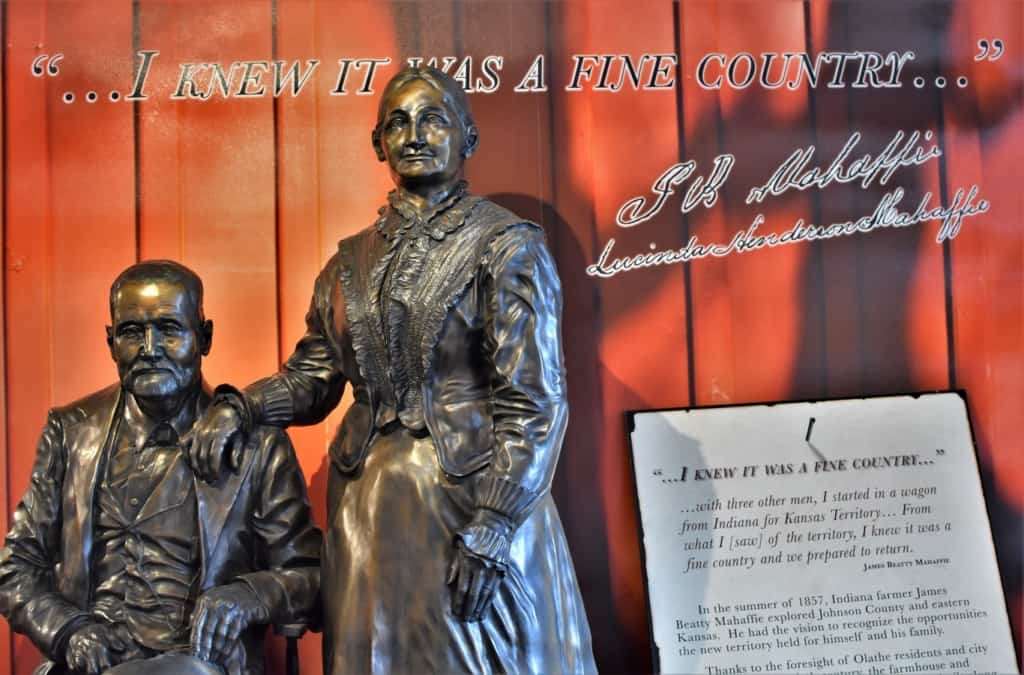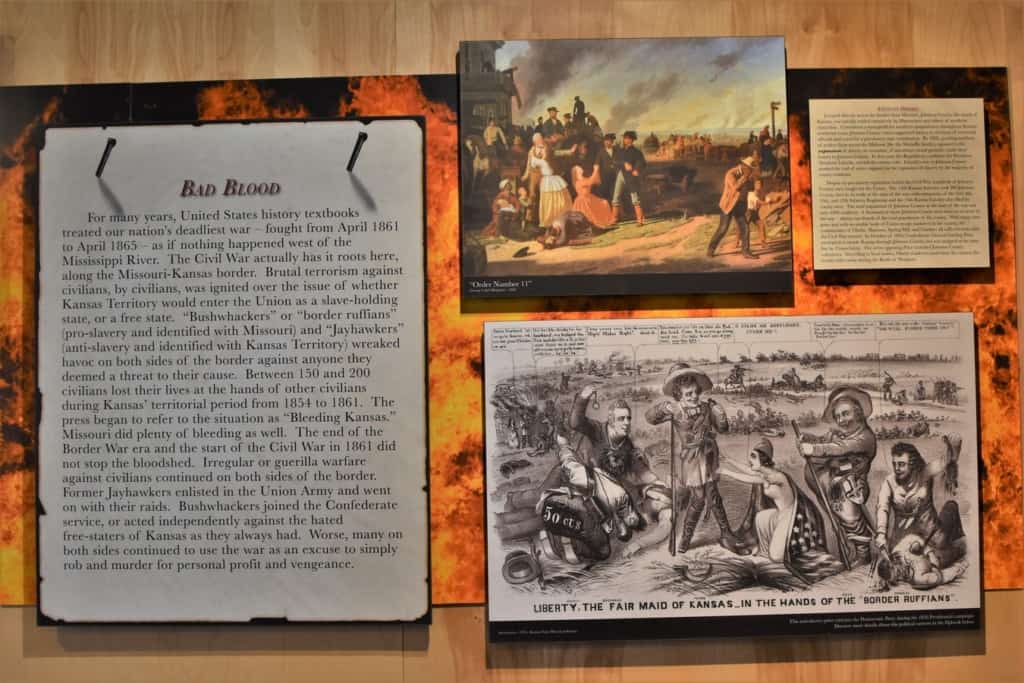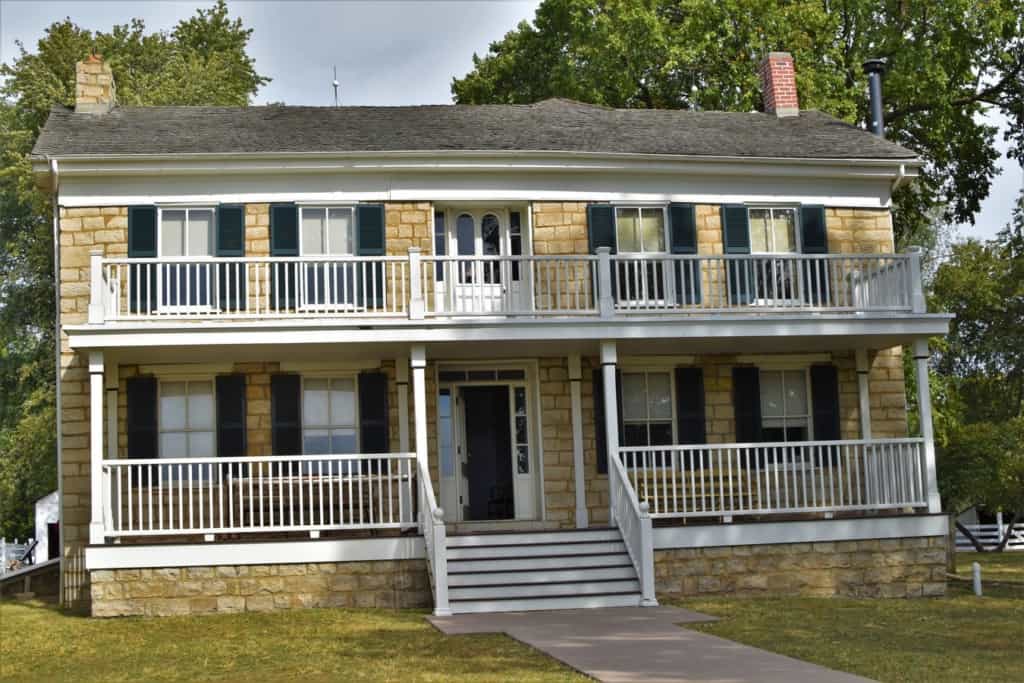A visit to the Mahaffie Stagecoach Stop takes guests back over 150 years, to a time when the territory was just opening for business. With so much history at this site, we were scratching our heads wondering why we had never visited. Knowing that nothing can be done to change the past, we pushed ahead with a plan to mend this oversight. A beautiful fall day in Kansas City offered us the perfect backdrop for our inaugural visit. We had plans to dive into all of the fun and educational opportunities that are found in this historic stop.

Moving to the Farm
James and Lucinda Mahaffie first arrived in Olathe in 1857. They lived in a wood-frame home, while their stone house was being constructed. With about 340 acres of farmland, there was plenty of room to grow. This location placed them along the eastern end of the Santa Fe Trail, which originated in Westport, Missouri. It was the Barlow, Sanderson, and Co. Stagecoach Line that contracted with the Mahaffies to create a new stop for their passenger line.

Bad Blood
Picking up your life and moving to a new region of the country must have been difficult in the mid-1800s. To make matters worse, Kansas was on the western edge of the Civil War and had gained a reputation for violence. In 1830, this region was known as “Indian Country”, since a number of tribes had been pushed westward with the country’s expansion. By the middle of the 1850s, a rolling tide of settlers was pushing into Kansas territory. The Kansas-Nebraska Act had ruffled the feathers of many in the region and the Missouri-Kansas border flared up with skirmishes and guerilla warfare. While many believed that the new residents were wholly concerned with the issue of slavery, in actuality land speculation was the growing topic. In the midst of this turbulent period, the Mahaffies were attempting to build a legacy.

Westward Movement
As early as 1858, the family began seeing travelers appear at the Mahaffie Stagecoach Stop. Within a few years, hungry passengers would descend upon the home looking to fill their bellies with home-cooked vittles. The basement kitchen served as a dining hall for guests. This gave the stagecoach crew time to switch horses for the next leg of their journey. Not wanting to rely too heavily on their future, based on being a stagecoach stop, the family engaged heavily in improvements to their farm. By the end of the 1860s, the railroad would arrive in Olathe and signal the future of passenger travel across the continent.

The Farmstead
The Santa Fe Trail would relinquish its role in the 1880s. By this time, James and Lucinda Mahaffie were about ready to retire. After that, they would move into town and the farm would change hands a few times over the decades. It wouldn’t be until 1979, that the City of Olathe would purchase the property. It was decided that it would best serve the community by being preserved and used to educate the public about days gone by. While the acreage has reduced, there are still plenty of activities to see and enjoy. They also host a variety of events, which is what brought us out to the Mahaffie Stagecoach Stop.

Entertaining Quackery
Each year, they host the Fall Harvest event, which brings loads of activity to the farmstead. Since our plan was to see it all, we decided to just meander down the gravel road that leads around the edge of the crop fields. It was here that we met our first character actor, who we must say was also the most eccentric. Professor Nigel Throckmorton is a phrenologist, which is a person who would study the shape of human heads. There are many views of this pseudoscience, but this gentleman was approaching it in the fashion that many would have in the mid-1800s. During that period, quackery was commonplace, as peddlers looked for ways to make some easy money off of unsuspecting and often gullible citizens. Of course, we enjoyed the boisterous ramblings of the professor.

Playing a Key Role
Just across from the professor, we spotted a barn that holds the blacksmith shop. From outside, we could hear the hammering and clanking of metal being worked. Stepping into the structure, we found the blacksmith hard at work. In the mid-1800s, this profession would have been highly coveted. Blacksmiths were the “jack of all trades” of their time. While men dominated the occupation, at those times, there were women who went into this field. To learn the trade, potential workers would apprentice to master blacksmiths. In exchange for their labor, the apprentice would be fed, clothed, and educated.

On-site Demonstrations
The tools of the trade would include an anvil for shaping the final pieces. Raw metals would be heated in a forge, which was fueled by charcoal. Bellows were used for stoking the fire to a moldable temperature. We watched as the on-site blacksmith worked an iron bar to create an S-hook. The combination of heating and beating formed the final shape. Once it was achieved, the piece was dipped in water to cool it off. It was obvious that this part of the job was enjoyed by those in the crowd. It must be something to do with the hissing and steam put off from the hot metal.

Mahaffie Stagecoach Stop
We had reached the middle of the property and came upon the stone house. Finished in 1865, this two-story structure also includes a basement area. This must have been quite a change from the original wooden structure, where the Mahaffies would charge visitors for space on the floor, to crash overnight. The new home boasted two-foot thick limestone walls to help keep the hot summers and cold winters at bay. All of the stone was quarried on the family’s farmland. It was estimated that at its peak, the Mahaffie Stagecoach Stop would have served upwards of 70 people per day.

Sewing Skills
Staff on hand for any given day may include a mix of regulars and volunteers. On the front porch, we found a seamstress busy with quilting. The warming sunshine made this a perfect spot to do the work and provided ample lighting. Inside, another person was busy ripping seams to reclaim fabric for future projects. Both seemed deeply engaged in their work but were happy to chat with guests.

It’s in the Details
As we looked around the home, we spotted many artifacts that would have been commonplace for that era. A wooden side table held an array of toys and games that would have kept the family occupied during periods after chores were completed. Out in the yard, we had watched younger visitors trying their hand at some of the activities we had seen at Missouri Town 1855. Situated on the opposite side of the Kansas City metropolitan area, it is another good historic stop.

Hands-on Lessons
Our next stop landed us downstairs in the basement. It was here that travelers to the Mahaffie Stagecoach Stop would have gathered. A staff member was in the midst of preparing a dish using the tools of the time. While many things have remained the same, cooking on a wood-fired stove has certainly changed. As a small group of visitors assembled, she walked us through the differences of today versus the mid-1800s. We enjoyed hearing the details behind the everyday activities.

Preserving the Past
One of the key activities, during the Fall Harvest, is the harvesting of sorghum. During a stagecoach ride around the grounds (included in the day’s admission), we witnessed workers hard at work in the fields. Another staff member was stationed in the yard, where the pressed sap was heated and reduced. The boiling is what creates the much sought-after sweetener named molasses. It would have been a key ingredient in households, throughout the country, in the 1800s. We watched the constant stirring for a while, before ending our educational visit at the Mahaffie Stagecoach Stop.






Thank you for another good article about an interesting place to visit. In addition to our personal love to travel around the USA, I coordinate visits to places in and around Kansas City for the senior adults from our church. We have been to several historic places in the last few years, but not to Mahaffie Stagecoach so thanks for another idea. Some of our senior adults have good mobility while others are slower or use walkers or canes. I looked at their website but couldn’t tell if the main building and house were accessible for people who avoid stairs, need paved or solid walking surfaces, and an occasional bench to sit on as they explore at least parts of the farm. Would someone with limited mobility be able to see much of it?
I would have to say it’s a mixed bag. The visitors center is certainly handicap accessible, but the farm does include some non-paved areas. I would reach out to the site to discuss options.
Still don’t know the address. Is it too much to put an address in the opening paragraphs ? I spied that it’s in Olathe, Kansas, somewhere, but I’m not from around here, so I don’t know specifically where to look or go. This is a disturbing trend in advertising that everyone seems to just assume the public knows where something is.
We are currently going through a complete redesign and will keep your comment in mind for new articles. Mahaffie is located at 1200 E. Kansas City Road in Olathe, Kansas.